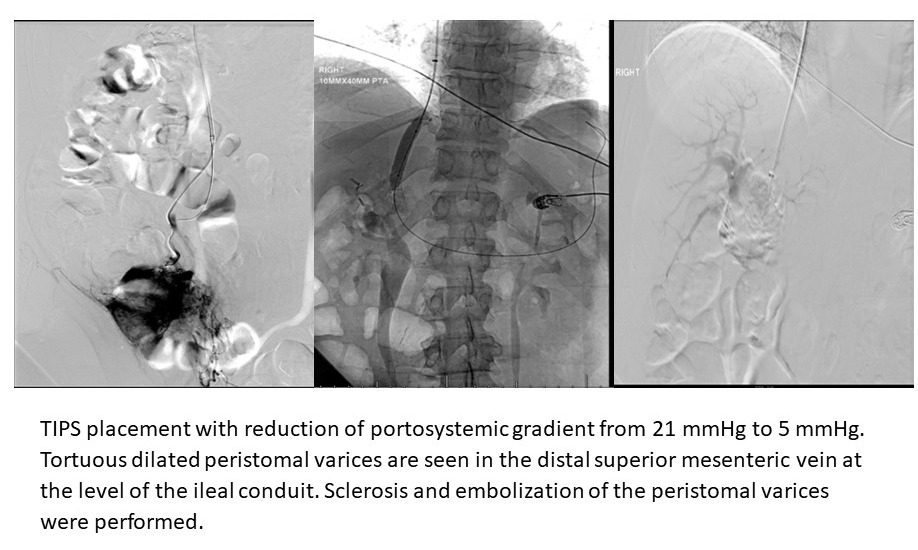Back
Poster Session A - Sunday Afternoon
A0520 - Transjugular Intrahepatic Portosystemic Shunt as a Cure for Macrohematuria
Sunday, October 23, 2022
5:00 PM – 7:00 PM ET
Location: Crown Ballroom

Ahmad Abulawi, MBBS
Albany Medical College
Albany, NY
Presenting Author(s)
Award: Presidential Poster Award
Ahmad Abulawi, MBBS1, Nicole Strossman, BS1, Ibrahim Khatim, MBBS1, Hadi Minhas, MD2, James J. Litynski, MD3
1Albany Medical College, Albany, NY; 2Albany Medical Center, Albany, NY; 3Albany Medical Center, Niskayuna, NY
Introduction: Varices most commonly form in the esophagus or stomach, however, they can form anywhere along the gastrointestinal tract. Ostomy-related varices can be challenging to diagnose and treat. Here, we discuss a rare case of recurrent bleeding from an ileal conduit urostomy due to ectopic varices successfully treated with a transjugular intrahepatic portosystemic shunt (TIPS).
Case Description/Methods: A-59-year-old male with a history of ileal conduit due to spina bifida complicated by neurogenic bladder, and alcoholic cirrhosis presented with a 3-weeks of recurrent bleeding from the urostomy site. The patient presented three times with bleeding from his urostomy site. Each time he received a blood transfusion and was seen by urology, and was subsequently treated with silver nitrate, cauterization, and suturing. The bleeding would stop temporarily and then recur. He eventually presented with reports of “fist-sized” blood clots pouring into his ostomy bag. Sutures were placed to tamponade the bleeding by Urology. Physical exam was significant for hypotension and palor. Laboratory tests were significant for hemoglobin of 6.0 g/dl. Gastroenterology was consulted and bleeding was thought to be due to ectopic variceal hemorrhage at the stoma site. TIPS was performed by Interventional Radiology. During the procedure, it was noted that there were tortuous dilated peristomal varices in the distal superior mesenteric vein corresponding to the ileal conduit, which were subsequently sclerosed and embolized (Figure 1). The patient was monitored for 48 hours after the procedure. On follow-up after 2 months, he continued to do well and without recurrence of bleeding.
Discussion: Hemorrhage from stomal varices is a rare but serious complication of portal hypertension. While the bleeding sometimes may be limited to one area and thus respond to manual compression, more commonly, the bleeding is diffuse and requires further intervention. There are a few treatment modalities that can be explored in these cases including decompression with TIPS, endoscopic band ligation, endoscopic sclerotherapy, glue injection, or surgery. Decompression with TIPS carries a lower rate of complication and re-bleeding rate compared to other lines of management. Our patient underwent TIPS which resulted in the cessation of bleeding without complications.

Disclosures:
Ahmad Abulawi, MBBS1, Nicole Strossman, BS1, Ibrahim Khatim, MBBS1, Hadi Minhas, MD2, James J. Litynski, MD3. A0520 - Transjugular Intrahepatic Portosystemic Shunt as a Cure for Macrohematuria, ACG 2022 Annual Scientific Meeting Abstracts. Charlotte, NC: American College of Gastroenterology.
Ahmad Abulawi, MBBS1, Nicole Strossman, BS1, Ibrahim Khatim, MBBS1, Hadi Minhas, MD2, James J. Litynski, MD3
1Albany Medical College, Albany, NY; 2Albany Medical Center, Albany, NY; 3Albany Medical Center, Niskayuna, NY
Introduction: Varices most commonly form in the esophagus or stomach, however, they can form anywhere along the gastrointestinal tract. Ostomy-related varices can be challenging to diagnose and treat. Here, we discuss a rare case of recurrent bleeding from an ileal conduit urostomy due to ectopic varices successfully treated with a transjugular intrahepatic portosystemic shunt (TIPS).
Case Description/Methods: A-59-year-old male with a history of ileal conduit due to spina bifida complicated by neurogenic bladder, and alcoholic cirrhosis presented with a 3-weeks of recurrent bleeding from the urostomy site. The patient presented three times with bleeding from his urostomy site. Each time he received a blood transfusion and was seen by urology, and was subsequently treated with silver nitrate, cauterization, and suturing. The bleeding would stop temporarily and then recur. He eventually presented with reports of “fist-sized” blood clots pouring into his ostomy bag. Sutures were placed to tamponade the bleeding by Urology. Physical exam was significant for hypotension and palor. Laboratory tests were significant for hemoglobin of 6.0 g/dl. Gastroenterology was consulted and bleeding was thought to be due to ectopic variceal hemorrhage at the stoma site. TIPS was performed by Interventional Radiology. During the procedure, it was noted that there were tortuous dilated peristomal varices in the distal superior mesenteric vein corresponding to the ileal conduit, which were subsequently sclerosed and embolized (Figure 1). The patient was monitored for 48 hours after the procedure. On follow-up after 2 months, he continued to do well and without recurrence of bleeding.
Discussion: Hemorrhage from stomal varices is a rare but serious complication of portal hypertension. While the bleeding sometimes may be limited to one area and thus respond to manual compression, more commonly, the bleeding is diffuse and requires further intervention. There are a few treatment modalities that can be explored in these cases including decompression with TIPS, endoscopic band ligation, endoscopic sclerotherapy, glue injection, or surgery. Decompression with TIPS carries a lower rate of complication and re-bleeding rate compared to other lines of management. Our patient underwent TIPS which resulted in the cessation of bleeding without complications.

Figure: Figure 1: TIPS placement with reduction of portosystemic gradient from 21 mmHg to 5 mmHg. Tortuous dilated peristomal varices are seen in the distal superior mesenteric vein at the level of the ileal conduit. Sclerosis and embolization of the peristomal varices were performed.
Disclosures:
Ahmad Abulawi indicated no relevant financial relationships.
Nicole Strossman indicated no relevant financial relationships.
Ibrahim Khatim indicated no relevant financial relationships.
Hadi Minhas indicated no relevant financial relationships.
James Litynski indicated no relevant financial relationships.
Ahmad Abulawi, MBBS1, Nicole Strossman, BS1, Ibrahim Khatim, MBBS1, Hadi Minhas, MD2, James J. Litynski, MD3. A0520 - Transjugular Intrahepatic Portosystemic Shunt as a Cure for Macrohematuria, ACG 2022 Annual Scientific Meeting Abstracts. Charlotte, NC: American College of Gastroenterology.


